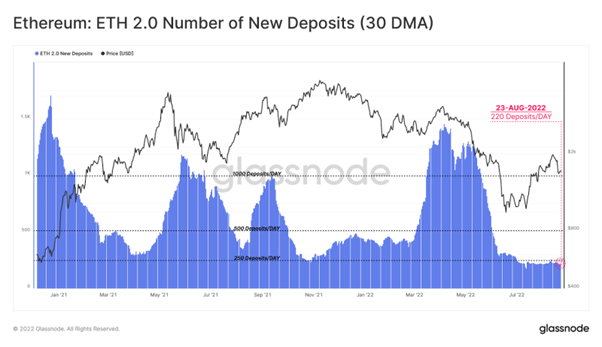Bitcoin Price: US$ 21,529.12 (+0.60%)
Ethereum Price: US$ 1,665.41 (+2.51%)
Manifold Finance Gains Traction As The Merge Approaches
- Near Protocol’s Rainbow Bridge repels an attack in 31 seconds, while attacker loses 5 ETH. No user funds were lost.
- Trader Joe introduces Liquidity Book, protocol for zero or low slippage trades of any size. Protocol is currently under audit.
- Coinbase faces a class action lawsuit that alleges the exchange failed to properly secure customer accounts.
- Invesco, an asset manager with more than $1 trillion under management, launches a metaverse fund.
- Daily active users on Manifold Finance have spiked since the beginning of August, indicating that users are staking FOLD tokens to earn a portion of the platform’s revenue. Following the Merge, the platform’s revenue is expected to increase as their router integrations become operational.
- Manifold Finance is a middleware protocol that provides access to high-value transaction pools on EVM-compatible chains. The protocol aggregates multiple endpoints such as Flashbots and Eden Network, while maintaining direct access to disparate mining pools or validator nodes.
- After the Merge, Ethereum will use a modular approach that will separate block building and block validation into two distinct activities, introducing a new stakeholder known as the block builder.
- OpenMEV will potentially allow Manifold Finance to become one of the largest block builders, once the Merge goes through. The protocol’s router is already connected to SushiSwap and is in the process of on-boarding Balancer and three top on-chain market makers.
- Additionally, the strategy lead for Flashbots, a competitor to Manifold, indicated on August 18 that they will comply with OFAC sanctions, making them susceptible to censorship. This likely aided the recent surge in users as the platform’s OpenMEV provides a credibly neutral platform for censorship resistance.
- Arbitrum launched about a year ago near the end of August 2021, getting close to $2B TVL due to a Nyan Cat Farm (not a typo) before dying down a couple days later.
- Ecosystems like Avalanche for EVM and Solana for non-EVM had momentum during this time and Arbitrum took a bit of a backseat. This lull in activity continued until TreasureDAO started driving activity to Arbitrum in Q1 ‘22 along with the perps exchange GMX, and then Arbitrum’s Odyssey campaign more recently.
- But the recent momentum for L2s is not limited to Arbitrum, as Optimism has seen a pick-up as well, albeit for a different reason.
- Optimism launched their “OP” token on June 1st, leading to a rush of users from L1 to claim these tokens and use the chain for the first time. Both have seen steady increases MoM since the beginning of the year and continue to trend up.
Celsius countersues KeyFi, claims deceit and incompetence led to tens of millions in losses
- Bankrupt crypto lending company Celsius countersued decentralized finance (DeFi) protocol KeyFi and its CEO Jason Stone on Tuesday in the United States Bankruptcy Court claiming Stone misrepresented himself as an expert in DeFi, and that Stone and KeyFi hadlost Celsius coins through incompetence and deceit. The suit came several weeks after KeyFi sued Celsius for allegedly failing to honor a profit-sharing agreement.
- KeyFi provided Celsius with staking services and DeFi strategy. According to the Celsius suit, the defendants allegedly stole millions of dollars in coins from Celsius wallets. Further, Celsius alleges that the defendants bought nonfungible tokens (NFTs) with Celsius coins without Celsius’ authorization and then transferred them to their own wallets before selling some for “seven figure returns (which they pocketed).” The defendants also allegedly bought an interest in other crypto companies with Celsius coins and used Tornado Cash, the crypto privacy protocol recently banned by the U.S. Treasury Department, to hide their activities.
- Celsius KeyFi was a co-plaintiff in the suit. It was a special purpose vehicle owned by Celsius that KeyFi worked within. The plaintiffs claimed they had lost “many tens of millions of dollars” through the defendants’ gross negligence and possibly tens of millions of dollars from converted assets. Further, they claimed that KeyFi failed to return funds when requested to do so and made frivolous claims against Celsius and tweeted about it:
- “As Stone clearly intended, the complaint and Twitter thread generated sensational media reports amplifying his false narrative.”
Iconic brands including Nike, Gucci have made $260M off NFT sales
- The hype surrounding nonfungible tokens (NFTs) has allowed some of the world’s most iconic brands to rake in hundreds of millions of dollars in additional revenue, underscoring the mass consumer appeal of digital collectibles.
- Leading brands including Nike, Gucci, Dolce & Gabbana, Adidas and Tiffany have amassed a combined $260 million worth of sales from NFTs, according to data from Dune Analytics that was first reported by NFTGators. Nike’s NFT drops have amassed $185.3 million in revenue, with volumes in secondary markets approaching $1.3 billion.
- Dolce & Gabbana has generated $25.6 million worth of NFT revenue. Tiffany, which only recently launched its NFTiff token allowing CryptoPunk holders to mint customized pendants, has amassed $12.6 million in NFT-related sales. Total NFT revenue for Gucci and Adidas was $11.6 million and $10.9 million, respectively.
Rep. Emmer demands an explanation of OFAC’s Tornado Cash sanction from Sec. Yellen
- United States Congressman Tom Emmer sent a four-page letter to Treasury Secretary Janet Yellen on Tuesday regarding the Treasury Department’s sanctioning of cryptocurrency mixer Tornado Cash on Aug. 8. In his letter, Emmer posed a series of questions that seek to clarify the position of the Treasury Department’s Office of Foreign Assets Control (OFAC).
- Emmer said that OFAC, acting under Executive Order 13694 to place Tornado Cash on its Specially Designated Nationals and Blocked Persons List (SDN), has for the first time extended the EO’s definition of person or individual to include code. He pointed to the distinction made by the Treasury’s Financial Crimes Enforcement Network (FinCEN) between anonymizing services and anonymizing software to illustrate the issue he saw in OFAC’s action while acknowledging that OFAC is not subject to FinCEN regulations.
China begins next phase of CBDC testing with e-CNY payment for public transport
- According to multiple sources, on Tuesday, China officially began rolling out the next round of its central bank digital currency (CBDC) pilot test program. In the city of Guanzhou, it is now possible to pay for public bus rides with the digital yuan (e-CNY) CBDC on 10 transit routes, which is a first for the country. To do so, passengers simply need to download the e-CNY app, deposit funds and scan the QR code located in the bus payment section to pay for their ride.
- Similarly, the day before, the city of Ningbo said that passengers can now pay for subway rides at 125 stations with e-CNY. Ningbo is the ninth city in China to roll out the e-CNY pilot test in its subway lines, where passengers can simply scan and pay for the journey.
- The Chinese government has rapidly expanded the utility of the e-CNY this year. Just last week, it became possible to pay for employee housing fund contributions in the city of Guangzhou with the CBDC. To revitalize consumer spending in the face of strict coronavirus lockdowns, the government partnered with food-delivery giant Meituan and e-commerce platform JD.com to create e-CNY air-drops that can be spent at listed venues.
- In its last data update dated June 20, over 6 million unique users had ordered services with e-CNY funds on Meituan. Meanwhile, as of July, JD.com said that it had processed more than 4 million e-commerce transactions worth an estimated 900 million CNY ($131.6 million) since it began accepting the e-CNY as tender. Approximately 830 billion ($121.4 billion) worth of e-CNY transactions were recorded in the first five months of 2022.
Plaintiff in Coinbase lawsuit raises issues of account lockouts, crypto as a security
- One user has filed a class-action lawsuit against crypto exchange Coinbase on behalf of account and wallet holders “who have had their accounts breached and incurred losses arising from the unauthorized transfer of assets.”
- In an Aug. 15 filing in the U.S. district court for the Northern District of Georgia, plaintiff George Kattula requested a jury trial against Coinbase, claiming the crypto exchange did not employ practices aimed at keeping users’ accounts secure and had “improperly and unreasonably” locked clients out of their accounts during periods of peak volatility in the crypto market. In addition, Kattula alleged that Coinbase should be registered as a broker or dealer in the United States as the platform handles the transfer of securities — in this case, cryptocurrencies.
- “Coinbase does not disclose that the crypto assets on its platform are securities,” said the lawsuit. “Indeed, Coinbase boldly flouts federal and state laws by proclaiming it does not need a registration statement for those securities and by refusing to register as a securities exchange or as a broker-dealer.”
- The filing added:
- “Crypto assets resemble traditional securities because they represent an investment in a project that is to be undertaken with the funds raised through the sale of the crypto (whether it be a “token,” “stablecoin,” or cryptocurrency). Investors purchase crypto with the hope that the crypto’s value will appreciate as the issuer creates some use that gives the crypto value.”
THORSwap launches Ethereum (ERC-20) Cross-Chain Aggregator
- Dear THORChads, the wait is finally over. A New Era for THORSwap has arrived! Today we integrate a full-featured Ethereum ERC-20 DEX Aggregator to THORChain’s flagship interface.
- THORSwap users can now swap between 4,800+ whitelisted ERC-20 tokens and Layer 1 blockchains such as Bitcoin, Binance Beacon Chain, Cosmos, Dogecoin, Litecoin, Bitcoin Cash, THORChain (and soon Avalanche) in a seamless, non-custodial manner without the use of bridges or wrapped assets
Hacker tries to exploit bridge protocol, fails miserably
- Cross-chain bridges have increasingly become targeted by malicious entities. However, not all hackers can run away with millions in their exploit attempts. Some end up losing money from their own wallets.
- In a Twitter thread, Alex Shevchenko, the CEO of Aurora Labs, told the story of a hacker who attempted to exploit the Rainbow Bridge but ended up losing 5 Ether (ETH), worth around $8,000 at the time of writing.
- According to Shevchenko, the hacker has presented a falsified NEAR block to the Rainbow Bridge contract and submitted the required 5 ETH safe deposit. Thinking that the team would be slow to react during the weekend, the attacker timed the exploit attempt on a Saturday.
- Despite the hacker’s plan, the CEO highlighted that there were automated watchdogs in place that fought off the malicious transaction. Within 31 seconds, the attempt was suppressed, leading to the hacker losing their safety deposit.
Bitcoin addresses in loss hit 1-month high as BTC price retests $21K
- Bitcoin (BTC) hodlers are feeling the squeeze this week as repeated tests of lower levels spark increasing losses.
- Data from on-chain analytics firm Glassnode shows more wallets are in the red as of Aug. 23 than at any time in the past month.
Bitcoin mining to cost less than 0.5% of global energy if BTC hits $2M: Arcane
- Bitcoin (BTC), the world’s most-valued cryptocurrency, has the potential to be a significant energy consumer in the future, but only if it reaches several million dollars, according to new estimates by Arcane Research.
- Crypto research and analytics firm Arcane Research on Monday released a report estimating the development in Bitcoin’s energy usage toward 2040.
- Authored by Arcane Research analyst Jaran Mellerud, the report points out that Bitcoin’s future energy consumption differs massively depending on the future Bitcoin price alongside factors like transaction fees, electricity prices and others.
- If the BTC price hits $2 million in 17 years, Bitcoin may consume 894 Terawatt-hours (TWh) per year, surging 10 times from today’s level, the report suggests. Despite huge growth, such energy consumption would only account for 0.36% of the estimated global energy consumption in 2040, increasing from Bitcoin’s 0.05% share today, the analyst estimated.
- “Currently, based on their energy consumption of 88 TWh and an average energy price of $50 per MWh, Bitcoin miners spend around 50% of their income on energy,” Mellerud noted.
The number of $ETH deposits into the Beacon chain contract is now at a stable but macro low of 220 deposits/day.
This may signify a stable holding pattern is been reached, as investors await a successful Merge, scheduled for mid-September.




